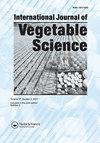Advances in pea breeding and genomics: From traditional techniques to modern approaches
Q2 Agricultural and Biological Sciences
引用次数: 1
Abstract
Peas, a highly valued annual legume vegetable with a rich history of domestication, are grown globally as a valuable export-oriented cash crop. Despite an increase in cultivation area and production, there has been only a slight improvement in green pea productivity, from 7.7 to 7.8 t/ha, over the last two decades. The primary focus for genetic improvement in peas is developing resistance to various biotic stressors, including diseases such as powdery mildew, downy mildew, rust, wilt, viral infections, and bacterial blight, as well as pests like leaf miners, aphids, pod borers, and pea stem flies. Traditional breeding approaches have played a significant role in the genetic improvement of peas, resulting in the development of several cultivars in various segments; however, advanced breeding techniques such as marker-assisted selection, genomic selection, and genome editing hold great promise in enhancing genetic improvement by facilitating the identification and selection of desirable traits, such as resistance to biotic and abiotic stressors, improved yield, and increased nutrient content, through the introduction of precise genetic modifications. By targeting specific genomic regions associated with desired traits, these techniques can increase the efficiency and precision of breeding programs, ultimately leading to the development of more resilient and productive pea varieties豌豆育种和基因组学进展:从传统技术到现代方法
豌豆是一种价值很高的一年生豆科蔬菜,具有丰富的驯化历史,是一种有价值的出口导向型经济作物,在全球范围内种植。尽管种植面积和产量有所增加,但在过去二十年中,绿豌豆的产量只有轻微的提高,从7.7吨/公顷提高到7.8吨/公顷。豌豆遗传改良的主要重点是发展对各种生物压力源的抗性,包括白粉病、霜霉病、锈病、枯萎病、病毒感染和细菌性枯萎病等疾病,以及像采叶虫、蚜虫、豆荚螟和豌豆茎蝇等害虫。传统的育种方法在豌豆的遗传改良中发挥了重要作用,导致了不同节段的几个品种的发展;然而,先进的育种技术,如标记辅助选择、基因组选择和基因组编辑,通过引入精确的遗传修饰,促进理想性状的识别和选择,如对生物和非生物应激源的抗性、提高产量和增加营养含量,在加强遗传改良方面具有很大的希望。通过瞄准与所需性状相关的特定基因组区域,这些技术可以提高育种计划的效率和精度,最终导致更具弹性和生产力的豌豆品种的发展
本文章由计算机程序翻译,如有差异,请以英文原文为准。
求助全文
约1分钟内获得全文
求助全文
来源期刊

International Journal of Vegetable Science
Agricultural and Biological Sciences-Plant Science
CiteScore
3.10
自引率
0.00%
发文量
30
期刊介绍:
The International Journal of Vegetable Science features innovative articles on all aspects of vegetable production, including growth regulation, pest management, sustainable production, harvesting, handling, storage, shipping, and final consumption. Researchers, practitioners, and academics present current findings on new crops and protected culture as well as traditional crops, examine marketing trends in the commercial vegetable industry, and address vital issues of concern to breeders, production managers, and processors working in all continents where vegetables are grown.
 求助内容:
求助内容: 应助结果提醒方式:
应助结果提醒方式:


